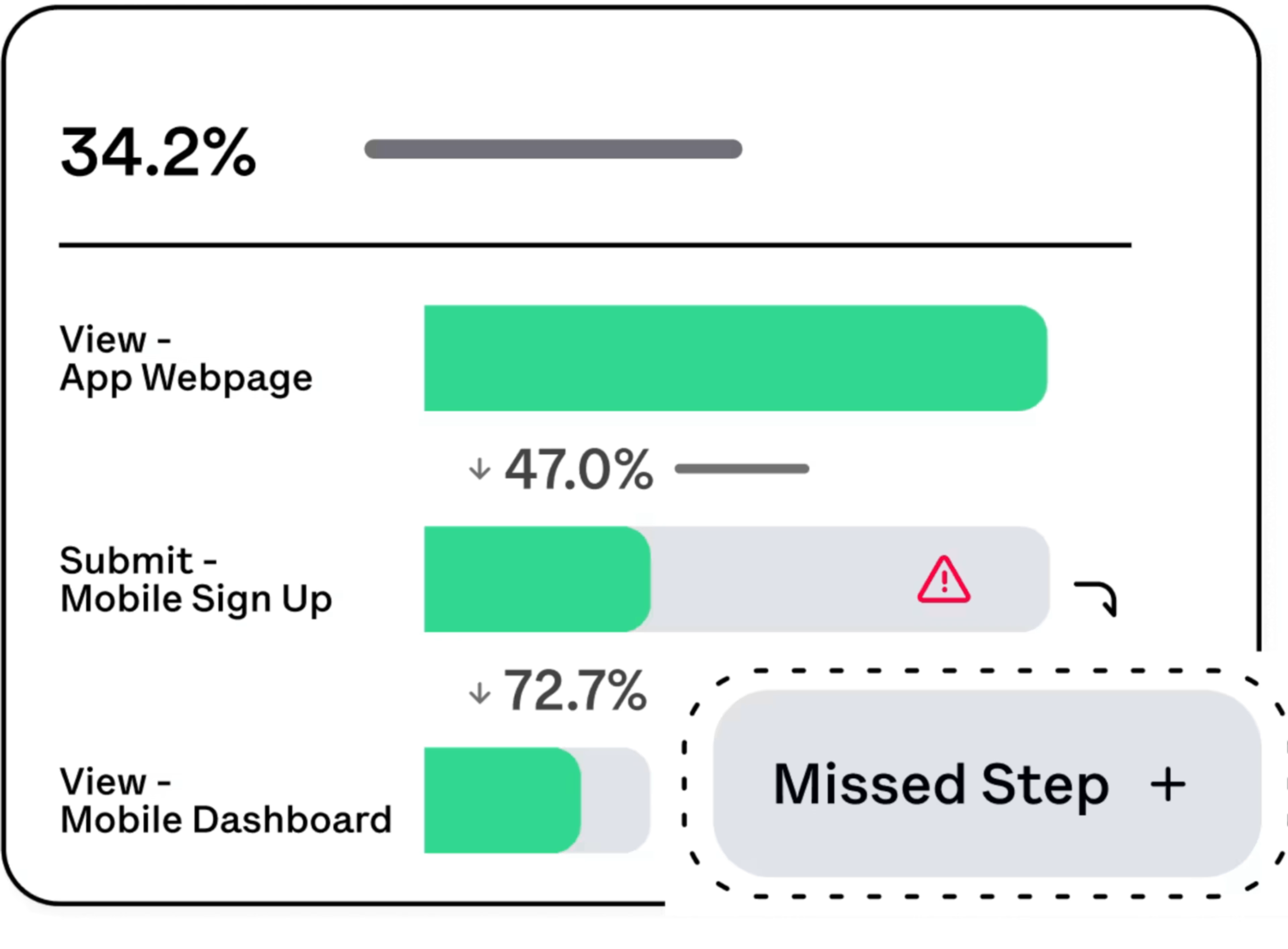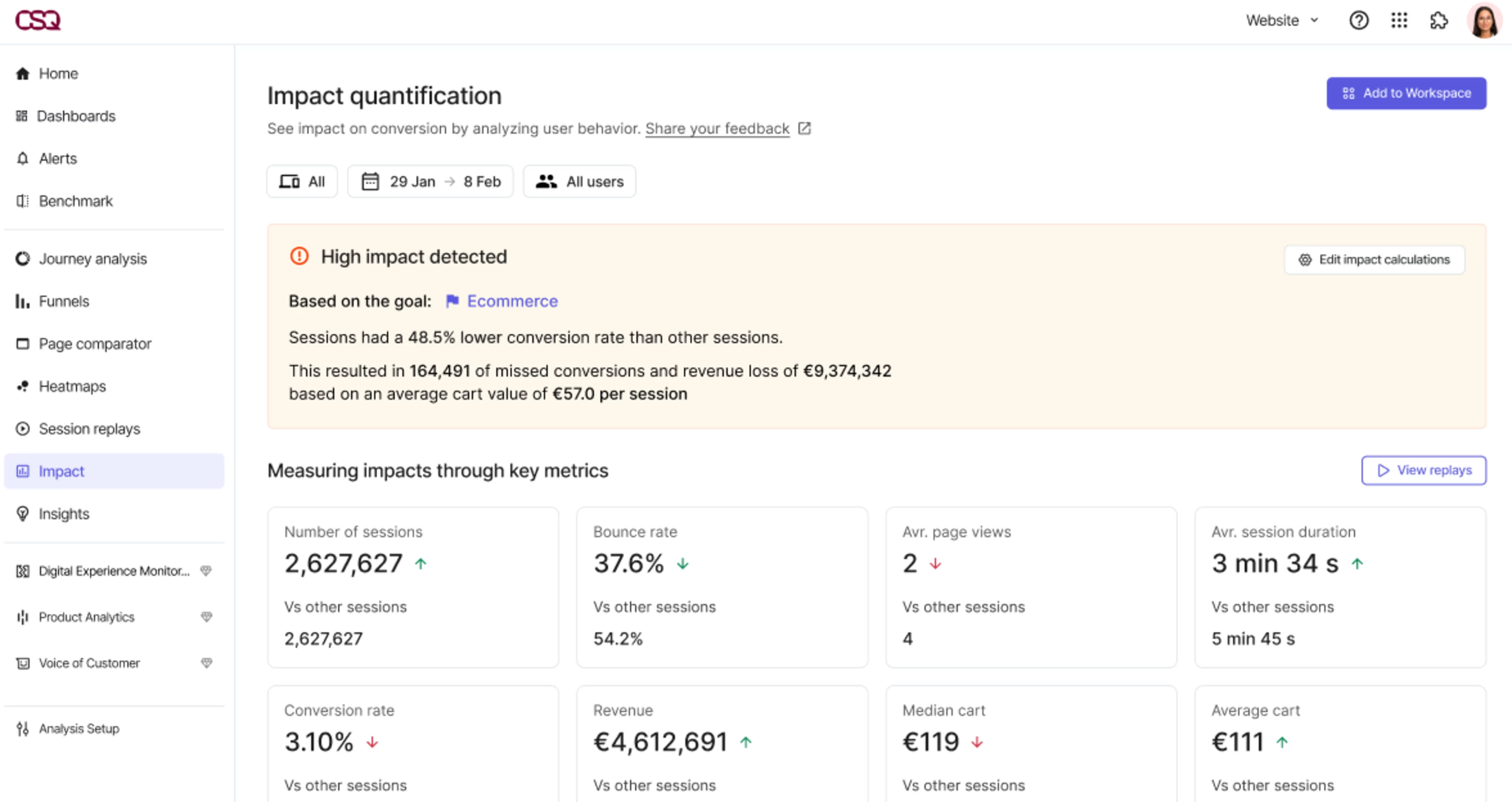A great mobile app experience starts with data—user data, to be exact. Data insights that provide answers to important questions, like what are your users doing that you aren’t aware of? Which mobile app features do they love, and which do they avoid? And, more importantly, why?
Follow these five mobile app analytics best practices to collect, track, report and analyze user behavior. This gives you a clear picture of how users engage with your app, where friction occurs in their journeys and what you need to optimize for that sought-after 5-star app review.
Understanding your mobile analytics promises rich rewards, but it's not without its challenges. Teams often have issues with ensuring their data is accurate, dealing with complicated integrations between different systems, and figuring out what to do with all the information they collect.
Whether you're a data scientist, product manager (PM) or marketing analyst, if you work with analytics, you've likely faced these challenges firsthand:
Constantly justifying investment in mobile features and capabilities, which often requires cross-platform analysis, comparing mobile and web performance
Understanding user behavior on both mobile, app and web versions, which can be time-consuming and complex
Capturing a complete picture of the user journey, which becomes even more difficult when using analytics tools that aren’t flexible
Managing different ideas within your team about what counts as an event
Updating your mobile application or changing the framework without throwing analytics tracking off
Regularly digging into analytics data can take up a lot of time, especially when you've got insights coming in from multiple platforms and devices (like iOS, Android and the web)
Ensuring every stakeholder gets the actionable info they need to do their job
With the right knowledge and tools, you can overcome these challenges, harness the full potential of mobile app analytics and use those insights to give users a better mobile experience. Here’s how.
Build a solid mobile app analytics foundation
Whether you’re launching a new app or improving the mobile version of your website, a solid analytics foundation gives you the insights you need to optimize your user experience (UX), justify investments and, ultimately, drive growth.
These three steps help you set up your mobile app analytics data collection for success.
Define clear goals and choose the right metrics to track
Setting clear goals for your mobile app analytics helps you achieve them faster.
For example, a mobile PM might set a goal to reduce user drop-off rates by 20% in a specific workflow where active users often switch from mobile to web because of usability issues.
Next, select the mobile analytics metrics you’ll track. These should be practical and show how well you’re hitting the goals you’ve just set. Some key metrics to track include installations, churn rate, retention rate, and active users.
Select your tools to effectively implement tracking
You’ll need an analytics tool that visualizes web and mobile metrics together in all the different ways you need to understand them. These cross-platform capabilities make it easy to compare key performance indicators and metrics and identify areas for improvement.
For example, mobile app analytics platforms (like Contentsquare 👋) let you track user behavior across devices, identify pain points and make changes to achieve your business goals.
Set up regular reporting and analysis
Keep up with reporting and analysis so you're always in the loop about what's happening with your app and the mobile version of your website.
For example, as a UX analyst, you might set up weekly reports on app engagement metrics and conversion rates. Using automated reporting tools makes it easier for your team to stay informed and make data-driven decisions—full visibility with much less hassle.
Pro tip: Use Contentsquare to automatically capture all user data, across all mobile platforms.
With an easy mobile app analytics set-up and no need to rely on busy engineers to implement code for you, Contentsquare's user-centric approach makes tracking analytics metrics a breeze. It lets you
Follow the user flow: Know what your active users are doing and why through Journeys and Session Replay
Make smart business decisions: All your team members have access to user behavior data to make informed business decisions
Build a seamless in-app experience: Mobile app experience analytics provide powerful insights to help you improve your product’s functionality and performance
Increase conversions: Deliver a mobile app that has your users at the forefront of its creation and maximizes paths to user engagement, conversion and retention
This way, you’re in control of all the key metrics you need to build mobile experiences that speak volumes to your customers and anticipate their needs.
![[Product illustration] How many users viewed the blog last week](http://images.ctfassets.net/gwbpo1m641r7/3gra21oatPPxhwINyMfCIO/2667d82526cafc26140788d497a3fa07/Screenshot_2024-12-04_at_14.56.21.png?w=1920&q=100&fit=fill&fm=avif)
Contentsquare helps elevate your user experience across web, mobile and apps
2. Segment your data to uncover app user journeys
Customer segmentation or breaking down your data into clean user segments and cohorts gives you some brilliant insights about your app users. Use this strategy to:
Reveal user journeys
Ever noticed users tapping, pinching or swiping endlessly? They might be stuck in loops that make no sense.
Segment your mobile analytics data according to user behavior and click through relevant session recordings to uncover these weird paths and fix them. This way, you give each user the attention they deserve and turn them into your biggest fans.
Pinpoint drop-off points
Complicated forms or unresponsive menus frustrate users and cause them to churn. Segmenting data helps you find these pain points so you can address them and keep users happy.
For example, you could set up a funnel to compare how traffic from social media, organic search and paid campaigns convert new users into trial sign-ups. Use funnel analysis to click through to relevant recordings of users who dropped off and see if they encountered errors or got confused by specific user interface (UI) elements.
Optimize every journey
Traditional metrics only scratch the surface. To really understand mobile users, you need deep insights on each user group, like ‘new vs returning users’ or ‘high-value customers’.
Segmenting and analyzing mobile data lets you observe and compare customers according to
Behavioral segmentation: segment by where users click, exit, churn, u-turn, enter text, encounter an error or trigger a conversion event
Technographic segmentation: segment by device, screen resolution, browser and operating system
3. Combine mobile and web analytics insights
Your users are seamlessly transitioning between devices, from their phones to their laptops and back again. To understand why they behave the way they do and what you can do to improve their in-app experiences, you need to perform cross-platform analysis, combining insights from mobile, apps, and web analytics.
This helps you start seeing patterns, connections and hidden opportunities that were previously invisible, giving you:
A deeper understanding of user behavior, preferences and interactions
With combined insights, you see where users start, where they stumble and where they succeed—painting a vivid picture of their journey that you can use to improve your mobile strategy.
For example, if you collect user feedback across devices, you can use those insights to tailor experiences and communications for each platform to user wants and needs, keeping them coming back for more.
Use Contentsquare’s voice of the customer tools to gather insights
A more complete picture of overall business performance
Integrated analytics provide more complete insights into what's working, what's not and where you can improve.
For instance, use web analytics to track purchases made on your eCommerce site and mobile app analytics to track in-app purchases. This combined data helps you identify trends, seasonal spikes and customer preferences, so you can adapt your sales strategies and maximize revenue.
More precise audience segmentation and targeting
Combine data from mobile, app and web analytics to create detailed user profiles. For example, a user might visit the desktop version of your website to browse products, then use the mobile app to check reviews and complete a purchase on their phone.
Consolidating data from all these interactions lets you build a comprehensive profile that includes browsing history, preferences and purchase behavior. This helps you deliver more tailored experiences, personalized marketing and specific product recommendations.
Pro tip: Easily combine cross-platform events with the click of a button.
To get a complete picture of your app performance, you need a tool that can automatically capture behavioral data across desktop, mobile and app.
Heap, part of the Contentsquare group, does just that. It keeps your data consistent and flexible across all platforms. No need to tweak or adjust metrics to see what happens when users switch between your app and website, making it easy to see and understand the complete customer journey.

Heap by Contentsquare makes it easy to capture a complete set of cross-platform data—web, native mobile, hybrid, IoT devices and more
4. Analyze customer behavior to improve the mobile experience
To create a mobile app experience users love, you first need to understand how they feel about the one you’re already offering. Your users are your best resource—if you know where to look, they show you what’s working, what’s not and how you can fix it.
Deep, nuanced, contextual and visually-impactful insights into the real behavior of your users come from using these Contentsquare mobile app analytics tools and features to investigate the root cause of their actions:
Zone-Based Heatmaps
Zone-Based Heatmaps show you where your users are spending their time on each screen and section.
Use them to see how your users interact with each mobile element—where they’re tapping, pausing, scrolling and swiping—and segment heatmap data to understand the behavior of the segments that matter to you most. Then, analyze and optimize at scale.
Customer Journey Analysis
With Customer Journey Analysis, you track the entire user journey, helping your team understand where users drop off and why.
Are certain actions, screens or journeys common causes of app glitches? Why are some paths successful and others not? Identifying common drop-off points allows you to make targeted improvements and increase your customer retention rate and lifetime value (LTV).
Session Replay
Session replays reconstruct an individual user session, allowing you to see how users interact with your app—from clicks to swipes and what technical errors they face.
Focus on specific behaviors that are the most meaningful to your business, like checkout completions or contact form submissions. Observe these sessions, investigate why things are going wrong from a user’s perspective and understand what you need to do about it.
Impact Quantification
Impact Quantification makes it easy for your team to focus on the most important problems first.
If you’ve uncovered issues through journey analysis, you can then calculate the effect of these issues to understand if the impact is a reasonable size or not. This doesn’t just help you make better, quicker decisions—it also means you can show stakeholders exactly how many conversions and how much ROI your decisions are driving.

Contentsquare’s mobile app analytics go beyond the touch and tap of traditional mobile analytics solutions
5. Optimize performance to fight frustration and improve mobile retention
Like most of your customers, mobile and app users expect fast and seamless experiences—no lengthy download times, no crashes and no in-app issues.
Analytics plays a key role in understanding these users, what drives them to stick around and uncovers behaviors that are helping or harming the user journey. They help you:
Monitor mobile and app performance
You can’t improve UX if you don’t know what isn’t working in the first place. Monitoring your mobile experience lets you uncover obstacles caused by technical issues, UX blockers and poor web and app performance.
Contentsquare's Experience Monitoring (DEM) captures performance metrics for every page and app screen. It combines behavioral and technical data to provide real-time insights—every click, tap, swipe, hover, event, error and text seen by your users. Having all this UX data helps you quantify the impact of these problems on business outcomes and user behavior.
For example, you could monitor a correlation between a high bounce rate on an app screen and response time to understand what’s negatively impacting users' experience and fix it.
Spot errors and crashes
Use crash and error analysis to detect and solve issues causing user frustration, uninstalls and bad reviews, so you can successfully address each of these app issues—before they do too much damage.
If you’re using Contentsquare, you actually get alerts of errors, performance issues and user frustrations. It lets you jump directly to relevant session replays to understand the context, drill into and share error details for a speedy resolution.
Collaborate with engineering teams
With DEM, you have a single data source that connects creative and technical teams, giving them the same insights. This makes it easy for your engineering team to proactively identify JavaScript, API, custom errors, and app crashes affecting your users.
Then, all that’s left to do is prioritize and quickly fix the issues that negatively affect your bounce and churn rate.
Next steps in mobile app analytics
Analytics helps you unlock the true potential of your mobile website and application. No more guessing what your users want or blindly launching updates and features, hoping they resonate with your audience—instead, you get to understand every user interaction, across platforms.
And with a proper set-up and these five mobile analytics best practices, you’ll build an app that not only speaks volumes to your users but anticipates their needs, delighting them with intuitive digital experiences across every touchpoint.
Keep reading to learn how to build mobile app user experiences that stand out from the crowd—and stay out of the recycle bin.
Mobile Analytics: A Complete Guide [homepage]
7 Mobile Analytics Metrics to Track
Mobile App Heatmaps: What They Are and How to Use Them
The 8 Best Mobile Analytics Tools in 2024

![[Visual] Contentsquare's Content Team](http://images.ctfassets.net/gwbpo1m641r7/3IVEUbRzFIoC9mf5EJ2qHY/f25ccd2131dfd63f5c63b5b92cc4ba20/Copy_of_Copy_of_BLOG-icp-8117438.jpeg?w=1920&q=100&fit=fill&fm=avif)